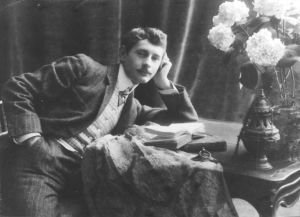Jacques d'Adelsward-Fersen: Difference between revisions
Created page with "Baron '''Jacques d'Adelswärd-Fersen''' (20 February 1880 – 5 November 1923) was a French novelist and poet. His life forms the basis of a fictionalised 1959 novel by Roger Peyrefitte entitled ''The Exile of Capri'' (''L'exilé de Capri''). In 1903, a scandal involving school pupils made d'Adelswärd ''persona non grata'' in the salons of Paris and dashed his marriage plans. For much of the rest of his life, he took up residence on Capri, a popular destination for hom..." |
No edit summary |
||
| (12 intermediate revisions by 2 users not shown) | |||
| Line 1: | Line 1: | ||
Baron '''Jacques d'Adelswärd-Fersen''' (20 February 1880 – 5 November 1923) was a French novelist and poet. His life forms the basis of a fictionalised 1959 novel by Roger Peyrefitte entitled ''The Exile of Capri'' (''L'exilé de Capri''). | __NOTOC__[[File:Jacques d'Adelswärd-Fersen photo.jpg|thumb|Jacques d'Adelswärd-Fersen]] | ||
Baron '''Jacques d'Adelswärd-Fersen''' (20 February 1880 – 5 November 1923) was a French novelist and poet. His life forms the basis of a fictionalised 1959 novel by [[Roger Peyrefitte]] entitled ''The Exile of Capri'' (''L'exilé de Capri''). | |||
In 1903, a scandal involving school pupils made d'Adelswärd ''persona non grata'' in the salons of Paris and dashed his marriage plans. For much of the rest of his life, he took up residence on Capri, a popular destination for homosexuals/pederasts of the time including [[Norman_Douglas|Norman Douglas]], [[Oscar_Wilde|Oscar Wilde]], [[Lord_Alfred_Douglas|Lord Alfred Douglas]], and Somerset Maugham, in self-imposed exile with his long-time lover, Nino Cesarini. He became a "character" on the island in the inter-war years, featuring in novels by Compton MacKenzie and others. His house, Villa Lysis, remains one of Capri's tourist attractions. | In 1903, a scandal involving school pupils made d'Adelswärd ''persona non grata'' in the salons of Paris and dashed his marriage plans. For much of the rest of his life, he took up residence on Capri, a popular destination for homosexuals/pederasts of the time including [[Norman_Douglas|Norman Douglas]], [[Oscar_Wilde|Oscar Wilde]], [[Lord_Alfred_Douglas|Lord Alfred Douglas]], and Somerset Maugham, in self-imposed exile with his long-time lover, Nino Cesarini. He became a "character" on the island in the inter-war years, featuring in novels by Compton MacKenzie and others. His house, Villa Lysis, remains one of Capri's tourist attractions. | ||
==Arrest and | We have archived a comprehensive and heavily sources historical article published in [[Paidika]], which details d'Adelsward-Fersen's relationship to pederasty and minor-attraction. See Will H.L. Ogrinc, [[File:Paidika10 pp. 32-60.pdf|A Shrine to Love and Sorrow: Jacques d'Adelsward-Fersen (1880-1923)]]. | ||
==Arrest and trial== | |||
{{Template:Moreinfo}} | |||
==Life on Capri== | ==Life on Capri== | ||
Giorgio Amendola, the future leader of the Italian [[Communism|Communist]] Party, who lived on Capri when he was eleven-years-old, led a small male-female gang in 1918, and wrote in his autobiography: | |||
<blockquote>''There were forbidden zones we were not supposed to set foot on. For instance, we were told never to draw near a white villa near ''[Monte]'' Tiberio, because ''[...]'' nasty things were happening there. Later I grasped that Fersen was meant, and his strange friendships. I was eleven years old, and the Caprian boys were of about my age. They knew very well the meaning of all these allusions.''<ref>Amendola, Giorgio (2001). Una scelta di vita. BUR Biblioteca Univ. Rizzoli.</ref></blockquote> | |||
==See also== | |||
<div style="column-count:2;-moz-column-count:2;-webkit-column-count:2"> | |||
*[[Pierre Louys]] | |||
*[[Andre Gide]] | |||
*[[Michel Foucault]] | |||
*[[Henry de Montherlant]] | |||
*[[Jean-Claude Féray]] | |||
*[[Alain Robbe-Grillet]] | |||
*[[Tony Duvert]] | |||
*[[Norman Douglas]] | |||
*[[Johann Wolfgang von Goethe]] | |||
*[[Thomas Mann]] | |||
</div> | |||
==References== | |||
[[Category:Official_Encyclopedia]][[Category:People]][[Category:People: Deceased]][[Category:People: Sympathetic Activists]][[Category:People: French]][[Category:People: Popular Authors]][[Category:People: Adult or Minor sexually attracted to or involved with the other]][[Category:People: Critical Analysts]] | [[Category:Official_Encyclopedia]][[Category:People]][[Category:People: Deceased]][[Category:People: Sympathetic Activists]][[Category:People: French]][[Category:People: Popular Authors]][[Category:People: Artists and Poets]][[Category:People: Adult or Minor sexually attracted to or involved with the other]][[Category:People: Historical minor-attracted figures]][[Category:People: Critical Analysts]] | ||
Latest revision as of 04:50, 8 December 2023

Baron Jacques d'Adelswärd-Fersen (20 February 1880 – 5 November 1923) was a French novelist and poet. His life forms the basis of a fictionalised 1959 novel by Roger Peyrefitte entitled The Exile of Capri (L'exilé de Capri).
In 1903, a scandal involving school pupils made d'Adelswärd persona non grata in the salons of Paris and dashed his marriage plans. For much of the rest of his life, he took up residence on Capri, a popular destination for homosexuals/pederasts of the time including Norman Douglas, Oscar Wilde, Lord Alfred Douglas, and Somerset Maugham, in self-imposed exile with his long-time lover, Nino Cesarini. He became a "character" on the island in the inter-war years, featuring in novels by Compton MacKenzie and others. His house, Villa Lysis, remains one of Capri's tourist attractions.
We have archived a comprehensive and heavily sources historical article published in Paidika, which details d'Adelsward-Fersen's relationship to pederasty and minor-attraction. See Will H.L. Ogrinc, File:Paidika10 pp. 32-60.pdf.
Arrest and trial
Call for input!
|
Life on Capri
Giorgio Amendola, the future leader of the Italian Communist Party, who lived on Capri when he was eleven-years-old, led a small male-female gang in 1918, and wrote in his autobiography:
There were forbidden zones we were not supposed to set foot on. For instance, we were told never to draw near a white villa near [Monte] Tiberio, because [...] nasty things were happening there. Later I grasped that Fersen was meant, and his strange friendships. I was eleven years old, and the Caprian boys were of about my age. They knew very well the meaning of all these allusions.[1]
See also
References
- ↑ Amendola, Giorgio (2001). Una scelta di vita. BUR Biblioteca Univ. Rizzoli.